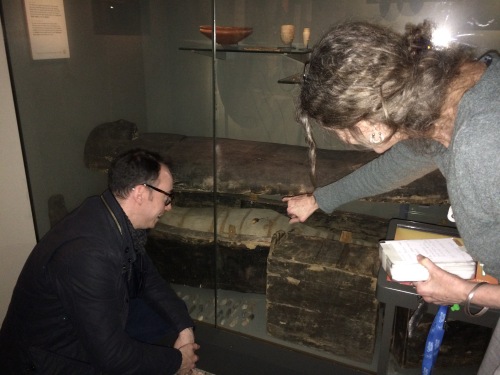https://egyptmanchester.wordpress.com/2018/03/24/curators-diary-march-2018-flowers-reunited-with-mummy-of-perenbast/
Curator's Diary March 2018: Flowers reunited with mummy of Perenbast
It is something of a love story: a man and woman (perhaps husband and wife) buried together for almost 3000 years. Their small tomb chamber at Dra Abu el Naga, on the west bank of Thebes, was excavated by W.M. Flinders Petrie's workers in 1908-1909.
Both individuals were provided with a single coffin, Ptah-Sokar-Osiris figure, and boxed shabtis. In a trend particularly prevalent during the Third Intermediate Period, floral material was left on both mummies. As part of the finds division system, one mummy (belonging to a temple singer named Perenbast) and her associated objects were sent to Manchester and those of her companion ('Mr Perenbast') sent to Bristol.
Some 10 years ago, while working on their new Egyptian gallery, Bristol Museum World Cultures curator Sue Giles recognised that their mummy had been provided with several flowers covered in black resin – when there was no resin on the mummy. The mummy of Perenbast in Manchester, however, had been covered in a thick coat of black resin and must have had some of her flowers inadvertently sent to Bristol.

Sue Giles pointing out the flowers on the mummy of 'Mr Perenbast'. Photo: Dyan Dodson.
In March 2018, thanks to Sue's efforts, an official transfer – signed by the Mayor of Bristol – was organised to reunite Perenbast with her flowers. Their identification as lotus flowers may obscure the fact that they are in fact blue waterlilies, about which there has been much debate. Regardless, the intended symbolism is of rebirth and regeneration.

Pressed blue lillies + illustrations in our Botany collection. Photo: Rachel Webster.
Perenbast and her coffin has been the subject of particular interest of late. They are featured in both a recent documentary about Karnak and an upcoming film on the discovery of KV 64, in which Dr Aidan Dodson of Bristol University and I discuss Perenbast's station in life. It is intriguing that both the (secondary) owner of KV 64 (Nehemesbastet) and Perenbast share the element 'Bast(et)', the feline goddess associated with the Delta, in their names. Perhaps the individuals were related, or at least part of a small group that had the same distinctive black coffin with decoration picked out in yellow or white. Both were beneficiaries of the intense reuse of tombs in the Third Intermediate Period.
-- Sent from my Linux system.
No comments:
Post a Comment